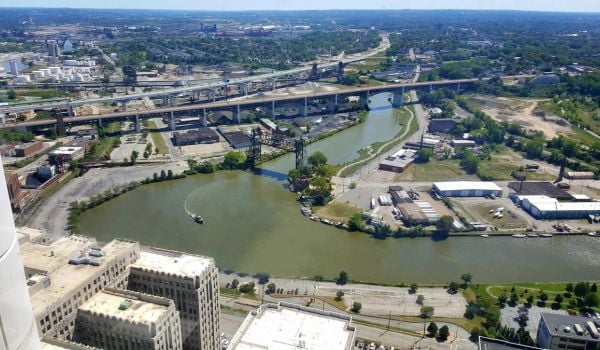The other day, I wrote about Philadelphia Green’s creative, but simple approach to vacant land repurposing in Philly’s distressed neighborhoods, and Vanguard member Phil Kidd’s frustration with his inability to enact similar policies in his hometown of Youngstown, Ohio. Today, we will examine how the federal government provides roadblocks to enacting “rightsizing” policies in old industrial cities, and what can be done to change this.
The most straightforward, and obvious problem for cities in decline is the way that the Department of Housing and Urban Development doles out its funds. Since 1974, HUD has given out economic development funds in the form of Community Development Block Grants, the bread-and-butter for so many people working at CDCs and the like. The grants are not competitive; cities must apply, but the size of the grant is determined by a formula. According the HUD website, the formula takes into account “poverty, population, housing overcrowding, age of housing, and population growth lag in relationship to other metropolitan areas.” But according to Phil Kidd, population counts the most, and in a city with a declining population, even more federal intervention is necessary to stop the bleeding. “CDBG is our lifeline,” explains Phil, “and we’re experiencing population decline and trying to plan accordingly for that but it requires a lot of planning and land use strategies, demolition…all these things that are not proportional to population.”
Even worse, as a city’s population declines, so does its tax base. This is where municipalities like Youngstown get hit with a one-two punch, as far as federal funds are concerned; Youngstown often has to use CDBG funds to cover gaps in its general fund. Not only do CDBG funds need to act as band-aids on city budgets, instead of going towards community development, they also have to cover what Phil calls the “other unintended consequences of neighborhood decline.” Phil’s example of how this works was as depressing as it was illustrative; Youngstown gets CDBG funds, but they sometimes need to be used to “cover general fund deficits that go to the fire department for an extra firetruck because of the amount of arsons.” Phil estimates that 1/4 to 1/3 of CDBG funds awarded to Youngstown go to patching up the city’s general fund. In his words, “that’s a problem.”
Phil’s second problem comes from the Neighborhood Stabilization Program that I wrote about last week. The funds awarded through that program have a 10% cap on demolition spending. In Youngstown, says Phil, that’s absurd. “The federal government has got to understand that the money we need for demolition is not to take a property that’s potentially salvageable and then demo it…this is abandoned property” — property that’s been left alone for anywhere from seven to twenty-odd years. Phil calls these “cancer cells.” By putting a cap on demolition spending, the federal government is keeping the Youngstown Neighborhood Development Corporation from “actually [stabilizing] a street or — by extension — a neighborhood.” That was the first NSP; Youngstown didn’t even get NSP2 funding because of a technical error on the application, combined with HUD’s perception that Youngstown lacked the organizational capacity to spend the funds effectively. By replacing the corporate-speak — “organizational capacity” — with the regular English — “staff” — in the previous sentence, you can see why Phil gets so frustrated with the Feds; small population leads to a small tax base, which in turn leads to a smaller city government, which leads to a rejected application for Neighborhood Stabilization funds. It really makes no sense.
Even more baffling to Phil is HUD’s insistence on affordable housing elements in work done with HUD dollars. “There’s 4500 vacant structures in Youngstown. We don’t need restrictions on affordable housing; there’s plenty of it!” On the one hand, our need for affordable, quality housing is the reason that HUD was part of the Great Society program in the first place — we can understand why they care about the issue — but expecting an affordable housing element in a plan for a city that largely focuses on blight removal is borderline Kafkaesque.
But even if Youngstown could secure the proper funding from HUD, they would run into problems with yet another Federal entity: the Environmental Protection Agency — the reason being the EPA’s strict, cost-prohibitive asbestos abatement requirements for demolitions. The language of the requirements is vague, but it boils down to this: the YNDC can only take down one building on any city block at a time. This is utterly useless for a place like Youngstown. “What ends up happening is a scatter-shot approach. You take one structure down there, you move to the next block, you take one down there. That doesn’t do anything for that neighborhood. There’s no one who wants to move in to that street. There’s no one who’s willing to invest in their own property…we’re throwing money down the drain.”
The asbestos problem lends Kidd’s “cancer cells” metaphor a truly sad second interpretation, and that’s not lost on him. But, he presents a reasonable argument for why the EPA’s asbestos abatement regulations might have unintended consequences: “If you’re looking at a street and you’ve got seven vacant houses on that street, 20 people still living there, young children, and there’s a church at the end of the street. And you say, if we’re gonna come here and actually knock down seven houses, and the amount of asbestos — whatever that actually ends up being — is released through a demolition, in the air. Versus those seven structures sitting there for the next 20 years or whatever it may be. What is more of a public health hazard?” Between the threats of arson, drug dealing and pests in vacant homes, Kidd argues that the decision is clear — a cost-benefit argument neither EPA bureaucrats nor anyone with cursory knowledge of medical ethics would find very compelling.
But still, it’s hard not to side with him. Phil’s sense of urgency makes his case that much more convincing, and that much more troubling. “In five years,” says Phil, “one neighborhood experienced a 435% increase in vacant property and abandonment. It’s literally gone. And this is a neighborhood that sits right up against a fairly affluent township south of the city.” That township is now experiencing the rising crime rates and vacancies that come with neighborhood decline. The vacancy cancer is spreading in Youngstown quite rapidly, and there’s little Phil, or others working in Youngstown can do to help stop it.
Phil says that not only do we need to fix to the way CDBG funds are allocated, demolition caps on NSP funding, and EPA asbestos abatement regulations, we also need a new program specifically designed to help places like Youngstown.
Congressman Tim Ryan from Ohio has already introduced a bill to the House called the Community Regeneration, Sustainability, and Innovation Act, which aims to solve these sorts of problems that Youngstown faces. The bill, should it pass, would allocate funds to HUD to “make grants and offer technical assistance to local governments…to design and implement innovative policies, programs, and projects that address widespread property vacancy and abandonment.” It was introduced to the House in February 2009, and it’s been in the hands of the Financial Services committee ever since.
“We’re ready to move forward,” says Phil, speaking for his hometown. But the question is: will Washington help?

_600_350_80_s_c1.jpg)





__Sean_Corrigan_from_Cleveland_Sews_(center)__and_Paula_Coggins_from_Oh_Sew_Powerful_(right)_sew_leftover_banners_from_the_NFL_Draft_into_handbags_-_photo_by_Sophie_Kannberg_600_350_80_s_c1.jpeg)







